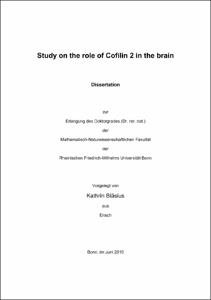Study on the role of Cofilin 2 in the brain

Study on the role of Cofilin 2 in the brain

| dc.contributor.advisor | Witke, Walter | |
| dc.contributor.author | Bläsius, Kathrin | |
| dc.date.accessioned | 2020-04-23T01:34:41Z | |
| dc.date.available | 2020-04-23T01:34:41Z | |
| dc.date.issued | 22.12.2016 | |
| dc.identifier.uri | https://hdl.handle.net/20.500.11811/6944 | |
| dc.description.abstract | Three actin depolymerization factors are expressed in the brain, named Cofilin 1 (non-muscle Cofilin), ADF and Cofilin 2, which was long declared as muscle-specific isoform. All three members share similar biochemical properties, but distinct knockout mouse models with a deletion of only one or two members of this family revealed isoform-specific functions, as well as functional redundancy in defined neuronal subcellular localizations. So far, only little attention was given to Cofilin 2 in the brain since the complete knockout displays a muscle-specific phenotype, while no changes in neuromuscular junctions were detected. The complete knockout of Cofilin 2 is postnatal lethal around P7. In this thesis the expression pattern of Cofilin 2 was studied during developmental time points of the brain starting from P0 until adulthood. A ubiquitous expression of Cofilin 2 was detected in all analyzed brain areas (olfactory bulb, cortex, hippocampus, striatum, cerebellum, hypothalamus and midbrain). Interestingly, the highest expression of Cofilin 2 was detected around P7, when the complete knockout was starting to become lethal. Colocalization studies revealed the expression of Cofilin 2 in neuronal subpopulations like dopaminergic, serotonergic, cholinergic, glutamatergic and GABAergic neurons. No expression of Cofilin 2 was detected in vivo in glial cells (astrocytes and microglia). Additionally an upregulation of Cofilin 1 and ADF was detected in the cortex, hippocampus and midbrain of P7 knockout animals, indicating a compensatory upregulation upon the loss of Cofilin 2. To study the exact role of Cofilin 2 in the brain, a mouse-line with a brain-specific deletion of Cofilin 2 using Nestin-Cre recombinase was analyzed. Cofilin 2fl/fl Nestin-Cre animals were viable, but displayed a reduced body size and weight compared to control animals. Histological analysis revealed no gross brain malformations, or alterations in cortical migration. A Golgi staining indicated a reduced dendritic arborization and changes in dendritic spine morphology, although the number of spines was not altered. A pre- and postsynaptic localization of Cofilin 2 was detected in synaptosomes. Electrophysiological studies revealed no changes in the frequency of spontaneous glutamatergic vesicle release or AMPA receptor number in Cofilin 2fl/fl Nestin-Cre animals. Further studies on inhibitory postsynaptic currents indicated an increased frequency of inhibitory vesicle release, while the amplitude was not significantly altered. As a next step behavioral tests were performed, but no changes upon the single loss of Cofilin 2 were detected. The dual loss of ADF and Cofilin 2 leads to a reduced anxiety-related behavior and impairments in working memory, indicating a functional redundancy for ADF and Cofilin 2 in these circuits. The obtained results indicate that ADF and Cofilin 1 are not able to compensate the complete loss of Cofilin 2 and highlight the contribution of Cofilin 2 in neuronal development, synaptic functionality and spine morphogenesis. Further the functional redundancy of ADF/Cofilin family members for specific brain functions was proven once more. | en |
| dc.language.iso | eng | |
| dc.rights | In Copyright | |
| dc.rights.uri | http://rightsstatements.org/vocab/InC/1.0/ | |
| dc.subject | Cofilin 2 | |
| dc.subject | actin | |
| dc.subject | brain | |
| dc.subject.ddc | 570 Biowissenschaften, Biologie | |
| dc.subject.ddc | 610 Medizin, Gesundheit | |
| dc.title | Study on the role of Cofilin 2 in the brain | |
| dc.type | Dissertation oder Habilitation | |
| dc.publisher.name | Universitäts- und Landesbibliothek Bonn | |
| dc.publisher.location | Bonn | |
| dc.rights.accessRights | openAccess | |
| dc.identifier.urn | https://nbn-resolving.org/urn:nbn:de:hbz:5n-45745 | |
| ulbbn.pubtype | Erstveröffentlichung | |
| ulbbnediss.affiliation.name | Rheinische Friedrich-Wilhelms-Universität Bonn | |
| ulbbnediss.affiliation.location | Bonn | |
| ulbbnediss.thesis.level | Dissertation | |
| ulbbnediss.dissID | 4574 | |
| ulbbnediss.date.accepted | 07.10.2016 | |
| ulbbnediss.institute | Mathematisch-Naturwissenschaftliche Fakultät : Fachgruppe Biologie / Institut für Genetik | |
| ulbbnediss.fakultaet | Mathematisch-Naturwissenschaftliche Fakultät | |
| dc.contributor.coReferee | Bradke, Frank |
Dateien zu dieser Ressource
Das Dokument erscheint in:
-
E-Dissertationen (4400)




